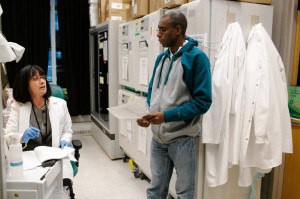from The Wall Street Journal,
10/19/14:
After Years of Delay, Researchers Rush to Field Test a Shot to Prevent the Disease

The world had little interest in Ebola in 1997, which is why cell biologist Nancy J. Sullivan thought she might be able to make a mark. Today, if the scientific world is to have an answer to the world’s severest Ebola outbreak, Dr. Sullivan’s work is likely to be at its center.
A senior investigator at the National Institutes of Health’s Vaccine Research Center, Dr. Sullivan has worked for years on a vaccine that has been proven to block Ebola in research monkeys. NIH is now racing to telescope what would have been a five- to 10-year testing plan into a few months. The vaccine is scheduled to undergo full human testing by early 2015 and could be in use potentially in time to help stem the disease in stricken West Africa.
There is no assurance this vaccine will work. It has competition from at least one other vaccine, which is running a month or more behind, being tested by the Public Health Agency of Canada and NewLink Genetics Corp. Either one might stop Ebola, or neither.
Experimental Ebola drugs are in the works to help treat existing cases. But these are generally in short supply, whereas GlaxoSmithKline PLC, which would be the manufacturer, thinks it could have one million doses of Dr. Sullivan’s vaccine available next year. That means, if all goes well, it could act as a firewall around a raging epidemic.
NIH already is doing safety studies in healthy people. Dr. Anthony S. Fauci, director of NIH’s National Institute of Allergy and Infectious Diseases, which includes the Vaccine Research Center, says the safety testing so far hasn’t turned up any “red flags.”
It’s unusual to try to perform a major clinical vaccine study, which would cover anywhere from 5,000 to 30,000 subjects, amid an epidemic, not to mention in a part of the world with bad roads and spotty electricity. The current plan, presented amid debate at a recent World Health Organization meeting in Geneva, is to run a study as rigorous as any domestic drug trial in which some health-care workers are randomly assigned to get vaccine and some to a placebo.
Among the questions that arise: Is that even ethical? Will workers amid an epidemic be willing to consider getting a placebo? Which villages won’t get vaccine? Will the rutted roads and overwhelmed medical systems even allow for such a study?
By late 1998, Dr. Sullivan had produced a vaccine candidate that she and colleagues at the Centers for Disease Control and Prevention in Atlanta tested in monkeys. On July 28, 1999, she received word via an email from the CDC that tests of blood serum samples from vaccinated test monkeys showed immune responses that, she says, “went through the roof.” She wrote “Yahoo!” in the margin of her lab notes, realizing they had broken new scientific ground.
The vaccine was tested in infected macaque monkeys in the most intensive protective environment known to man, called BSL-4 or Biosafety Level-4, at the CDC, and later by Army researchers at Ft. Detrick in Maryland. Unvaccinated monkeys became sick and died within about a week. The four vaccinated monkeys had no detectable virus-something science had never before accomplished.
“These findings demonstrate that it is possible to develop a preventive vaccine against Ebola virus infection in primates,” wrote Drs. Sullivan, Nabel and colleagues in a letter to the journal Nature in Nov. 2000.
Scientists were impressed. Everyone else shrugged. The recently retired chief of vaccines at Merck & Co. said “there’s no market for this.” The Wall Street Journal wrote of “the relatively tiny risk posed by Ebola.”
That was crushing,” Dr. Sullivan recalls. She tried using cold viruses from chimpanzees. Several versions later, she and colleagues from NIH, Ft. Detrick and Glaxo’s Okairos unit reported in the journal Nature Medicine this year that they had “generated, for the first time, durable protection against lethal Ebola virus challenge.”
After getting clearance from the Food and Drug Administration, the NIH began in September preliminary human-safety testing. The next stage—performing a clinical study in West Africa—is a far taller order. The vaccine needs to be kept at basically the temperature of dry ice. That will mean a minus 80-degree Centigrade freezer in a country with a spotty power system.
More From The Wall Street Journal (subscription required):













